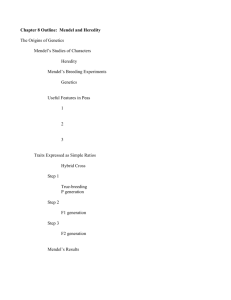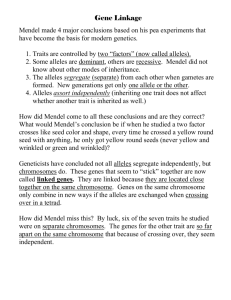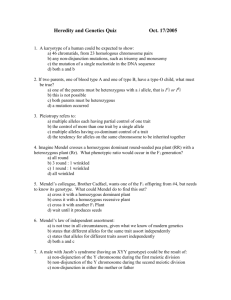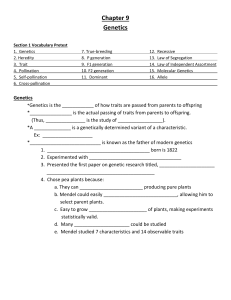Punnett Squares
advertisement
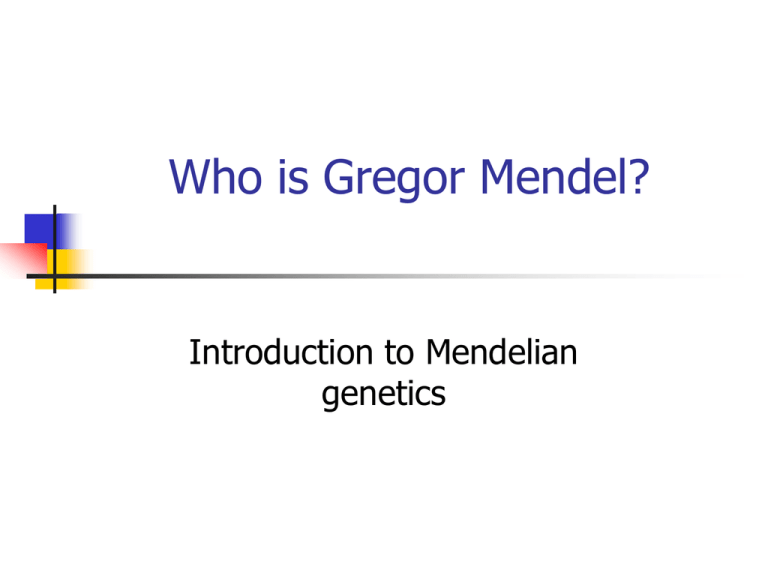
Who is Gregor Mendel? Introduction to Mendelian genetics TRUE OR FALSE? 1. 2. 3. 4. 5. 6. 7. 8. 9. Girls inherit more traits from their mother than their father You have inherited traits that are not apparent Color blindness is more common in males than females Identical twins are ALWAYS the same sex A person can transmit genetic traits to their offspring which they themselves DO NOT show The father determines the sex of a child The total number of male births exceeds female births each year Acquired characteristics, like mathematical skills, can be inherited Fraternal twins are more closely relates to each other than to other siblings Answers 1. 2. 3. 4. 5. 6. 7. 8. 9. False True True True True True True False False Genetics The field of Biology devoted to understanding how characteristics are passed from parents to offspring Gregor Mendel In the 19thcentury, Mendel studied heredity-which is the transmission of characteristics from parent to offspring Mendel is most famous for studying pea plants He studied what he called “factors” in pea plants Factors would be things like tall or short (height), or yellow or green (pod color) Some of Mendel’s Factors Gregor Mendel First, Mendel grew true-breeding plants According to Mendel, true-breeding plants are plants that will always produce offspring with the same traits So a true-bred pea plant with purple flowers will only produce plants with purple flowers because it only has the “factors” for purple (not white). Gregor Mendel: P generation Mendel bred two opposite true-breeding plants For example, he bred a true-breeding purple flower pea plant and a true-breeding white flower pea plant He called this his P generation – parent generation Gregor Mendel: F1 generation All of the offspring of the P generation (which he called the F1 generation) turned out purple Mendel called purple flower color the dominant factor He hypothesized that when the dominant factor was present, the recessive factor(white color) did not show. Gregor Mendel: F2 generation Next, Mendel crossed the offspring from the F1 generation (he called this the F2 generation) –He observed that about 75% of the flowers were purple and about 25% were white –This is equal to about a 3:1 ratio Mendel P Generation(true-breeding parents) Purple flowers F1 Generation(hybrids) F2 Generation All plants had purple flowers White flowers Mendel’s Real Results Mendel’s Laws Keep in mind that Mendel knew nothing of Punnett squares, genes, alleles, or even DNA!!! All he could do was observe phenotypes and record ratios and other statistics He came up with 2 important laws as a result of his observations. Mendel’s Laws: Law of Segregation Mendel concluded that each plant gets two factors (alleles) for a characteristic and when the plant reproduces, these two factors separate or segregate. So… Each gamete (sex cell) gives one factor (allele) AND therefore… Each offspring gets one factor from each parent Law of Segregation: Punnett Squares Alleles separate Alleles separate Mendel’s Laws: Law of Independent Assortment Mendel did experiments using more than one trait (like height and seed color) He noticed that one trait did not influence the inheritance of another trait In other words, different factors separate independently of each other during the formation of gametes Mendel’s Laws: Law of Independent Assortment Examples: Pea plants can be short or tall Their seeds can be green or yellow Short plants can have green or yellow seeds Tall plants can have green or yellow seeds So the inheritance of one does not affect the inheritance of the other. Mendel noticed this with all the traits he studied Independent Assortment Mendel’s Laws Independent Assortment is not always true•If different genes are located on the same chromosome, then they will most likely be inherited together •These are called Linked Genes What were Mendel’s factors in reality? We call these alleles today –Alleles are alternative forms of a gene Alleles for flower color were purple and white The characteristics (like height) are caused by genes on DNA Genes are segments of DNA that code for one protein Each gene has 2 alleles, or versions (1 from mom and one from dad) What were Mendel’s factors in reality? The reason alleles come in pairs is because chromosomes come in pairs (homologous pairs)!! •One allele on each chromosome! •WHAT A COINCIDENCE!!! The Genetics of Mendel’s Experiments Some Vocab Dominant trait-masks the recessive Shown with capital letters Recessive trait-only shows if dominant is not present Shown with lower case letters Phenotype-physical appearance For example purple, wrinkled, tall, etc The Genetics of Mendel’s Experiments Some Vocab Genotype-genetic makeup This is usually abbreviated with letters like Gg, FF, or hh Genotypes for a trait are usually2 letters because you get 2 alleles (1 from mom and 1 from dad) Homozygous-two of the same alleles (like HH or hh) Heterozygous-two different alleles (like Hh) The Genetics of Mendel’s Experiments Mendel’s P generation had the genotypes FF (for purple) and ff (for white) True breeding is also homozygous FF is homozygous dominant ff is homozygous recessive The Genetics of Mendel’s Experiments We can show the results Mendel observed using a Punnett Square: A Punnett Square shows possible genetic combinations in the zygotes Mendel crossed his true breeding purple and white flower pea plants We write this as FF x ff LET’S DO THIS ON THE BOARD The Genetics of Mendel’s Experiments What Mendel did not know: All of F1 pea plant flowers heterozygous (two different alleles), or Ff That is why they were all purple Remember dominant alleles mask recessive alleles So with one purple allele present and one white, only purple would show as it is dominant F2 generation LET’S EXAMINE EACH RATIO FOR EACH CROSS: F2 Generation What genotypes do you start with? How are they crossed? What are your results? What is the genotypic ratio (genes)? What is the phenotypic ratio of purple (F) to white (f)? Punnett Square Examples •Let’s do a Punnett square for BB x Bb •B= black fur in bunnies •b= white fur in bunnies •Black fur is dominant •What is the genotypic ratio? •What is the phenotypic ratio? •What are the chances for a white bunny? Punnett Square Examples •Let’s look at a heterozygous cross •Bb x Bb •What is the genotypic ratio? •What is the phenotypic ratio? •What are the chances for a white or black bunny? Predicting the Results of Heredity What do these ratios and percents mean? If we flip a coin, there is a 50% chance that it will land on heads. But it is still possible to get 5 tails in a row (although it is highly UNLIKELY!) The more times you flip it, the more likely your results will be 50:50 If Bb and Bb bunnies mate, there is a 1:4 chance the offspring will be white (this does NOT mean that they will or will not have white bunnies) If they have LOTS of children, about 25% of them will be white REMEMBER… Homozygous dominant means 2 BIG letters Heterozygous means one big one little Homozygous recessive means 2 little letters If an organism shows the dominant trait, then the can be either heterozygous OR homozygous dominant Test Cross When genotypes are not known, a test cross can be performed to figure it out The organism with an unknown genotype is crossed with a homozygous recessive individual. Test crosses are often used in breeding (like dog breeding) to determine is organisms are really “pure bred” (homozygous) for desired characteristics Test Cross Problem: Let’s say you want to breed black bunnies and you do not want any white bunnies What would be the only parents’ genotypes to produce black bunnies? BB x BB There are 2 ways to know for sure which black bunnies are homozygous and which are heterozygous: expensive genetic testing, or test crosses Test Cross Solution: We take some black bunnies and mate them with white bunnies (homozygous recessive) Let’s look at the Punnett Square results to see the possible results Remember, black bunnies can be either BB or Bb Test Cross – Punnett Squares (try each cross) If a BB is crossed with bb, no white bunnies are produced If a Bb is crossed with bb, then white bunnies may be produced If a test cross produces white bunnies, we know the unknown genotype is Bb; if not the genotype is BB The cross would be performed multiple times to be sure of the results Predicting Dihybrid Crosses When 2 traits are being looked at… Let’s do a cross between two heterozygous tall, heterozygous purple flowered pea plants So, TtFfx TtFf For each plant, we now look at genotype for color and height Predicting Dihybrid Crosses Instead of 2 possible gametes, there will be 4 So, the Punnett Square will be 4 x 4 Phenotypic Ratios Tall, purple : tall, white : short, purple : short, white Keep same letters together, capitals 1st You will not be asked for genotypic ratios for dihybrid crosses What are the phenotypic ratios? LET’S DO IT ON THE BOARD Complex Inheritance Mendel observed monogenic traits and no linked genes…It’s not usually that simple…. Other Types of Inheritance Incomplete Dominance The phenotype of the heterozygote is intermediate between phenotypes of the dominant and recessive traits Example: when a homozygous red carnation is crossed with a homozygous white carnations, then pink carnations are produced We usually don’t use lower case letters in this type of inheritance because nothing is really dominant Incomplete Dominance •RR = Red •RW= pink •WW= white Let’s look at the cross on the board Other Types of Inheritance Codominance Occurs when both alleles for a trait are expressed in heterozygous offspring Codominant alleles are often symbolized with different letters Codominance BB = Brown BW= Roan WW= White Notice both brown and white are present in the heterozygous genotype Codominance LET’S EXAMINE THE PUNNETT SQUARE ON THE BOARD Roan x Roan BW x BW What are the ratios for each phenotype? Other Types of Inheritance Multiple Alleles: Genes with 3 or more alleles (or variations) Human blood type shows codominance and it has multiple alleles-A, B, and O Blood Type Human blood types have 3 alleles A, B, and O. Each person still only gets 2 alleles, but there are 3 possibilities O is recessive to A and B, A and B are codominant: Genotype AO or AA = A blood Genotype BO or BB = B blood Genotype OO = O blood Genotype AB = AB blood (both alleles expressed) Blood Type Terminology Heterozygous B Heterozygous A Homozygous recessive Homozygous A Homozygous B AB(technically heterozygous) Genotype BO AO OO AA BB AB Codominance Punnett Square LET’S EXAMINE THE PUNNETT SQUARE ON THE BOARD Heterozygous A with Heterozygous B AO x BO What are the ratios for each phenotype? Other Types of Inheritance Sex-Linked Genes and Traits Remember sex chromosomes are the chromosomes that determine the sex of an organism So these are traits/genes carried on sex chromosomes These traits are symbolized using a superscript on the X or Y, such as Xr or XR Other Types of Inheritance Sex-Linked Genes and Traits Examples: In fruit flies, the gene for eye color is on the X chromosome. Red (XR) is dominant, white (Xr) is recessive. To have white eyes, females must have the genotype XrXr, or in other words TWO white alleles To have white eyes, males must have the genotype XrY, or in other words ONE white allele This is why X chromosome sex-linked traits are more common in males Try the Punnett Square Homozygous red eyed female x white eyed male R R x XrY X X What are the ratios for each phenotype? Other Types of Inheritance Polygenic Inheritance: Traits that are controlled by more than one gene Most human traits are polygenic Examples are height, skin color, eye color, and hair color Other Types of Inheritance Complex Characters: Characters that are influenced by genetics AND the environment Skin color and height are examples Other Types of Inheritance Sex-Influenced Traits: Traits in which males and females show different phenotypes even though they have the same genotypes Baldness is an example- it is dominant in men, but recessive in women The differences are mainly due to males and females producing different hormones (chemical signals) Other Types of Inheritance Single Allele Traits Traits where there is only one allele If you have the allele you have the trait-there is no recessive Huntington’s disease is an example Pedigrees Another way to show heredity…. Pedigree is a chart or “family tree” that tracks which members of a family have a particular trait. Pedigrees In pedigrees, carriers have one copy of the recessive allele So they CARRY the trait, but they do not show it Pedigrees can be used to make predictions about Future offspring The genotype of individuals in the pedigree Pedigrees The first pedigree tracks the widow’s peak, so the filled in shapes have a widow’s peak Widow’s peak is a dominant trait Carriers are not always shown on pedigrees Think about what alleles their parents can give them First generation(grandparents) Ww ww ww Ww Second generation(parents plus aunts and uncles) Ww ww ww Ww WW Ww ww or ww Third generation (two sisters) Ww Dominant trait (widow’s peak) ww= no widow’s peak WW= widow’s peak Chromosome Mutations Chromosome mutations involve changes in the structure of a chromosome or the loss or gain of a chromosome. –Deletion: The loss of a piece of chromosome due to breakage –Inversion: A chromosomal segment breaks off, flips around, and reattaches -Missence: A change in chromosomal arrangement by insertion of DNA segment Translocation-A piece of chromosome breaks off and reattached to a nonhomologous chromosome Chromosome Mutations Nondisjunction-When a chromosome fails to detach from its homologue during meiosis, so one gamete gets an extra chromosome Instead of a haploid number (n) or diploid (2n), the gamete has 3 chromosomes (3n) Chromosome Mutations (Examples) Down’s syndrome Nondisjunction of chromosome 21 in the egg cell produces 3 copies of chromosome 21 Symptoms include: heart defects, stunted growth, mental retardation Cystic fibrosis Can be caused by several mutations on chromosome 7 (insertion, missence) Symptoms include: problems with respiratory and digestive systems Chromosome Mutations (Examples) Klinefelter’s syndrome A male receives an extra X chromosome (XXY) because of nondisjunction of egg cell Symptoms: Boyish, rounded look (despite age) and often infertility Trisomy 18 (Edward’s syndrome) Nondisjunction of chromosome 18 results in 3 copies of chromosome 18 Much more severe problems than Down’s syndrome. Only 10% of births survive to their first birthday

